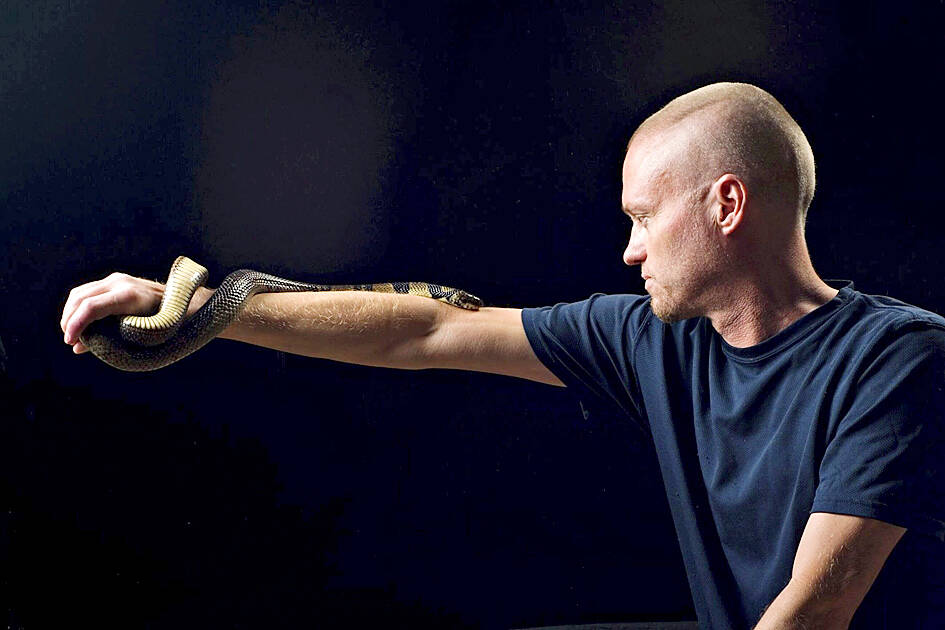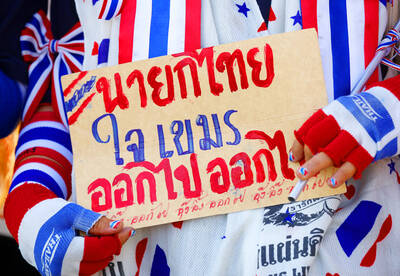Tim Friede has been bitten by snakes hundreds of times — often on purpose. Now scientists are studying his blood in hopes of creating a better treatment for snake bites.
Friede has long had a fascination with reptiles and other venomous creatures. He used to milk scorpions’ and spiders’ venom as a hobby and kept dozens of snakes at his Wisconsin home.
Hoping to protect himself from snake bites — and out of what he calls “simple curiosity” — he began injecting himself with small doses of snake venom and then slowly increased the amount to try to build up tolerance. He would then let snakes bite him.

Photo: Centivax via AP
“At first, it was very scary,” Friede said. “But the more you do it, the better you get at it, the more calm you become with it.”
While no doctor or emergency medical technician — or anyone, really — would ever suggest that is a remotely good idea, experts said his method tracks how the body works. When the immune system is exposed to the toxins in snake venom, it develops antibodies that can neutralize the poison. If it is a small amount of venom, the body can react before it is overwhelmed. If it is venom the body has seen before, it can react more quickly and handle larger exposures.
Friede has withstood snakebites and injections for nearly two decades and still has a refrigerator full of venom. In videos posted to his YouTube channel, he shows off swollen fang marks on his arms from black mamba, taipan and water cobra bites.
“I wanted to push the limits as close to death as possible to where I’m just basically teetering right there and then back off of it,” he said.
However, he also wanted to help. He e-mailed every scientist he could find, asking them to study the tolerance he had built up.
There is a need: About 110,000 people die from snakebite every year, according to the WHO.
Making antivenom is expensive and difficult. It is often created by injecting large mammals such as horses with venom and collecting the antibodies they produce. These antivenoms are usually only effective against specific snake species, and can sometimes produce bad reactions due to their non-human origins.
When Columbia University medical sciences professor Peter Kwong heard of Friede, he said: “Oh, wow, this is very unusual. We had a very special individual with amazing antibodies that he created over 18 years.”
In a study published Friday in the journal Cell, Kwong and collaborators shared what they were able to do with Friede’s unique blood: They identified two antibodies that neutralize venom from many different snake species with the aim of someday producing a treatment that could offer broad protection.
It is very early research — the antivenom was only tested in mice, and researchers are still years away from human trials. While their experimental treatment shows promise against the group of snakes that include mambas and cobras, it is not effective against vipers, which include snakes such as rattlers.
“Despite the promise, there is much work to do,” Liverpool School of Tropical Medicine snakebite researcher Nicholas Casewell wrote in an e-mail.
Friede’s journey has not been without its missteps. He said after one bad snake bite, he had to cut off part of his finger, and some particularly nasty cobra bites sent him to the hospital.
Friede is now employed by Centivax, a company trying to develop the treatment and that helped pay for the study.
He said he is excited that his 18-year odyssey could one day save lives from snakebite, but his message to those inspired to follow in his footsteps is simple: “Don’t do it.”

Eleven people, including a former minister, were arrested in Serbia on Friday over a train station disaster in which 16 people died. The concrete canopy of the newly renovated station in the northern city of Novi Sad collapsed on Nov. 1, 2024 in a disaster widely blamed on corruption and poor oversight. It sparked a wave of student-led protests and led to the resignation of then-Serbian prime minister Milos Vucevic and the fall of his government. The public prosecutor’s office in Novi Sad opened an investigation into the accident and deaths. In February, the public prosecutor’s office for organized crime opened another probe into

RISING RACISM: A Japanese group called on China to assure safety in the country, while the Chinese embassy in Tokyo urged action against a ‘surge in xenophobia’ A Japanese woman living in China was attacked and injured by a man in a subway station in Suzhou, China, Japanese media said, hours after two Chinese men were seriously injured in violence in Tokyo. The attacks on Thursday raised concern about xenophobic sentiment in China and Japan that have been blamed for assaults in both countries. It was the third attack involving Japanese living in China since last year. In the two previous cases in China, Chinese authorities have insisted they were isolated incidents. Japanese broadcaster NHK did not identify the woman injured in Suzhou by name, but, citing the Japanese

YELLOW SHIRTS: Many protesters were associated with pro-royalist groups that had previously supported the ouster of Paetongtarn’s father, Thaksin, in 2006 Protesters rallied on Saturday in the Thai capital to demand the resignation of court-suspended Thai Prime Minister Paetongtarn Shinawatra and in support of the armed forces following a violent border dispute with Cambodia that killed more than three dozen people and displaced more than 260,000. Gathered at Bangkok’s Victory Monument despite soaring temperatures, many sang patriotic songs and listened to speeches denouncing Paetongtarn and her father, former Thai prime minister Thaksin Shinawatra, and voiced their backing of the country’s army, which has always retained substantial power in the Southeast Asian country. Police said there were about 2,000 protesters by mid-afternoon, although

MOGAMI-CLASS FRIGATES: The deal is a ‘big step toward elevating national security cooperation with Australia, which is our special strategic partner,’ a Japanese official said Australia is to upgrade its navy with 11 Mogami-class frigates built by Japan’s Mitsubishi Heavy Industries, Australian Minister for Defence Richard Marles said yesterday. Billed as Japan’s biggest defense export deal since World War II, Australia is to pay US$6 billion over the next 10 years to acquire the fleet of stealth frigates. Australia is in the midst of a major military restructure, bolstering its navy with long-range firepower in an effort to deter China. It is striving to expand its fleet of major warships from 11 to 26 over the next decade. “This is clearly the biggest defense-industry agreement that has ever